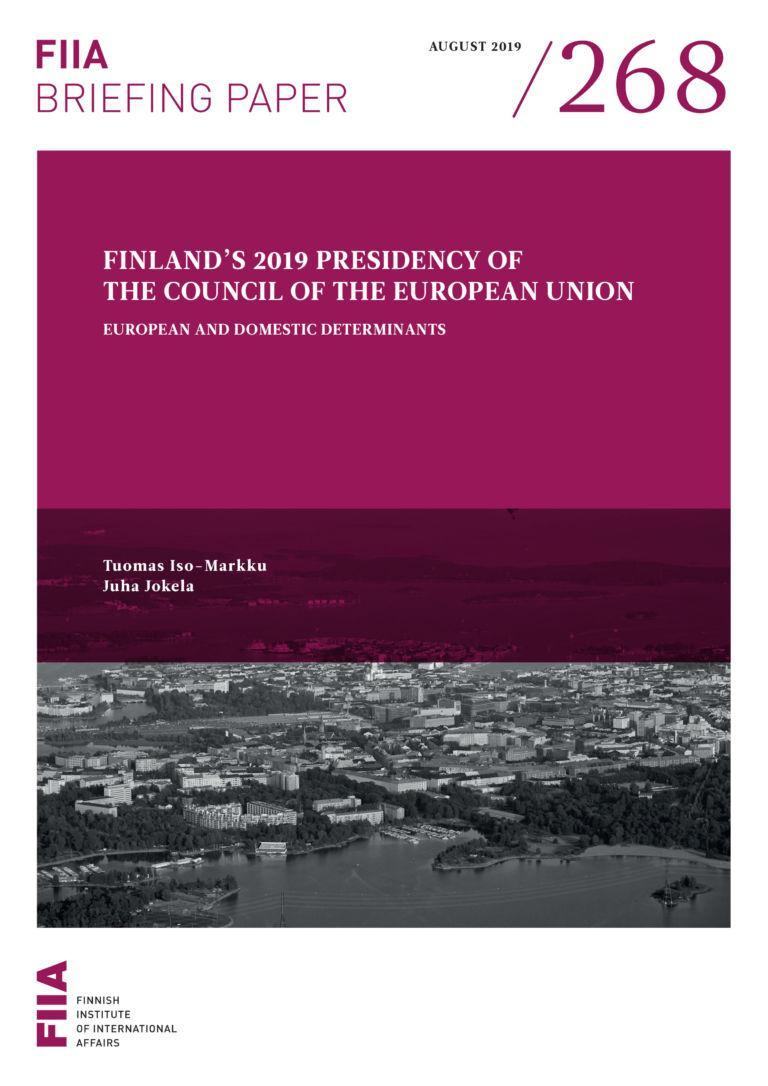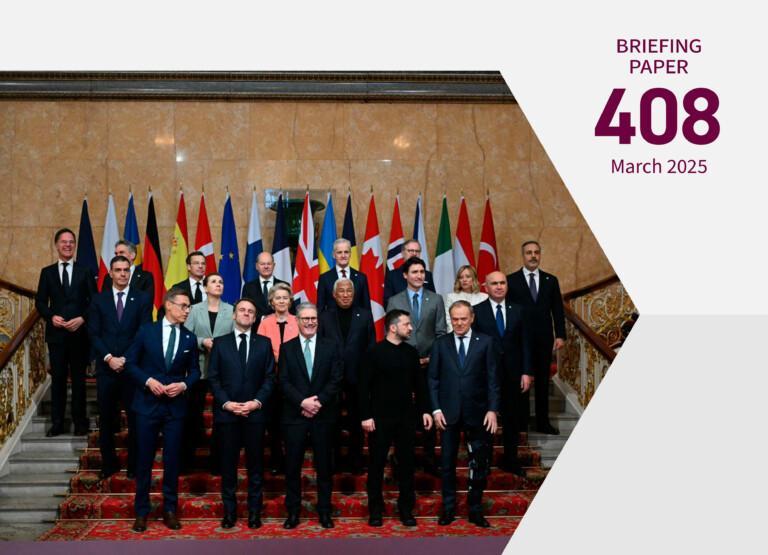
The Finnish presidency of the Council of the EU faces a sensitive political climate, marked by divisions between the member states. However, some of the EU’s recent crises have also given the Union a renewed sense of purpose: striking the right balance between ambition and realism will therefore be a key challenge for Finland.
During its presidency, Finland will have little legislative work, but can help in setting the EU’s priorities for the next five years, advancing the negotiations on the Multiannual Financial Framework and managing the Brexit process.
The rise of the Eurosceptic Finns Party in the late 2000s had a crucial impact on Finland’s EU policy. This was reflected in harder and, at times, obstructive positions on EU issues. However, recently a new consensus on EU affairs seems to have emerged among the other parties.
Antti Rinne’s new government is striving for a stronger EU with a presidency programme that resonates with the strategic agenda of the European Council, but also corresponds with the more limited role of post-Lisbon Treaty presidencies.
Introduction
On 1 July 2019, Finland took over the rotating presidency of the Council of the European Union. It is Finland’s third presidency since joining the Union in 1995, with the previous ones taking place in 1999 and 2006. Hence, Finland already has experience in handling the duties of the presidency. At the same time, the context for the 2019 presidency is in many respects very different compared to Finland’s earlier presidencies.[1]
First, both the presidency as an institution and the EU as a political community have undergone crucial changes since Finland last presided over the Council. The Lisbon Treaty made significant modifications to the prerogatives of the rotating presidency, whereas the EU as a community is still recovering from a series of crises that has markedly sharpened the Union’s internal divisions. This means that Finland faces a very different set of challenges and opportunities than during its two previous presidencies. In addition, as in 1999, the Finnish presidency coincides with the beginning of a new institutional cycle in the EU.
Secondly, Finland has witnessed notable developments as a member state as well. In the past ten years, Finland’s political landscape has been shaped by the rise of the populist and Eurosceptic Finns Party, which triggered the breakdown of the country’s long-standing domestic consensus on EU policy. However, more recently, a new EU policy consensus seems to have emerged. It is against this backdrop that the freshly elected five-party government of Prime Minister Antti Rinne has set Finland’s presidency priorities. Finland’s Council presidency is therefore also indicative of how Finnish EU policy may look in the years to come.
This Briefing Paper takes a closer look at both EU-level and domestic factors that shape Finland’s 2019 presidency of the Council and what they mean for the presidency and Finnish EU policy at large. The Briefing Paper starts by discussing the EU-level determinants of the presidency and moves on to analyse the domestic political setting.
A more constrained presidency
The presidency of the Council as an institution was significantly modified by the Lisbon Treaty. Most notably, the treaty established the office of the permanent President of the European Council. Thus, when it comes to the European Council, all of the former key functions of the rotating presidency now fall under the remit of the permanent president.
Similarly, the rotating presidency’s role in the EU’s external policy, and more specifically the Common Foreign and Security Policy (CFSP), was circumscribed. The main decision-making bodies in this policy area – the Foreign Affairs Council, the Political and Security Committee, as well as most of the different CFSP-related working groups – are now chaired by the High Representative of the Union for Foreign Affairs and Security Policy and her/his staff at the European External Action Service, not the presidency country. In addition to these bodies, the Eurogroup – which is not a regular Council configuration – falls outside the scope of the rotating presidency as well.
Finally, the Lisbon Treaty affirmed the system of trio presidencies, originally introduced in 2006. All post-Lisbon presidencies therefore operate as part of pre-set teams that consist of three consecutive presidency countries. While each country has its own presidency programme, the trios also agree on a joint programme that reflects shared priorities.
Apart from formal treaty provisions, broader political and inter-institutional trends clearly have an impact on the rotating presidency as well. Thus, many observers argue that the multiple crises of recent years have strengthened the role of the European Council, which is expected to show political leadership and settle the most complicated political issues. As the rotating presidency is no longer responsible for organising and chairing European Council meetings, its visibility and influence have diminished considerably.
A sensitive political environment
Every presidency can count on having to deal with several controversial political issues. However, while political strife and different types of crises are nothing new for the Union, there are good grounds for arguing that the EU of 2019 is significantly different from the EU of 1999 or 2006.[2] The conglomeration of internal and external crises that the EU has had to cope with in the last ten years has left its mark on the Union.
Most importantly, many of the crises – above all the Eurozone crisis, the refugee crisis as well as the conflicts over respect for the EU’s values and rule of law – have had a negative impact on the EU’s unity, strengthening divisions that run between (and within) member states and duly affecting the Union’s key institutions as well. In many cases, these divisions have made it very difficult for the Union to agree on lasting solutions to the challenges it faces, forcing it to focus on short- and medium-term fixes instead. This means that some of the recent crises – and the intra-EU divisions related to those crises – may flare up again anytime. Every presidency country needs to learn to navigate this sensitive political environment, in which the presidency’s ability to act as a mediator may be of particular use.
Finland has already got a taste of the charged political climate during the first weeks of its presidency. Since mid-July, Finland has been a target of harsh criticism on the part of media outlets and figures close to Hungary’s ruling party Fidesz, including party leader and Prime Minister Victor Orbán himself. Orbán’s government, subject to a European Parliament-initiated disciplinary procedure to prevent it from breaching the EU’s founding values, is disappointed with Finland for making the rule of law into one of its presidency priorities. Consequently, Orbán and his allies have set out to question Finland’s credentials as a proponent of the rule of law by presenting misleading and unfounded claims about shortcomings in the Finnish judicial system and media landscape.
However, the crises of recent years have also served to prove the EU’s adaptability and resilience. Despite the difficult political conditions, the EU has been able to manage the most burning challenges, safeguarding its viability as a political community. Moreover, many of crises have provided the Union with a new sense of purpose. Russia’s aggression in Ukraine, breaches of the rule of law in Hungary and Poland, Brexit, and US foreign policy under the leadership of President Donald Trump all challenge the EU’s core values and key achievements in different ways, but they also underline the Union’s role in defending and protecting things that have long been taken for granted. Growing concerns related to climate change and increasing global competition could reinforce this effect further by more clearly showing the (potential) benefits of EU action.
The renewed sense of purpose can generate stronger public backing for, and interest in the EU, as has already been indicated by recent opinion polls and the increased turnout in the 2019 European Parliament elections. This should create additional motivation for the presidency countries, including Finland, to formulate tangible policy priorities and objectives that respond to the key concerns of EU citizens. At the same time, a key challenge for any presidency will be to strike the right balance between political ambition and realism.
An EU in transition
A central determinant of Finland’s 2019 presidency is that it takes place during a time of institutional transition following the European Parliament elections of May 2019. The transition phase is the time when the EU formulates its agenda for the next five-year institutional cycle. While the agenda is shaped by several actors and through different processes, a skilful presidency has the opportunity to leave its imprint on the Union’s priorities.
A first step in determining the future agenda was already taken before the start of the Finnish presidency. In June 2019, the European Council adopted a broad strategic agenda for the period 2019–2024 consisting of four general objectives: protecting citizens and freedoms; developing a strong and vibrant economic base; building a climate-neutral, green, fair and social Europe; and promoting European interests and values on the global stage. These objectives – together with the priorities of the European Parliament’s major political groups – will then flow into the agenda of the European Commission. Finland, as the representative of the Council, can potentially have an important role in this process by supporting new Commission President Ursula von der Leyen in formulating the Commission’s priorities and translating them into a more concrete legislative programme.
The transition phase means that Finland’s role in managing actual legislative work will be limited. However, there is still an array of crucial issues to be dealt with. One of the major items on the EU agenda during Finland’s presidency will be Brexit. After the United Kingdom’s two-year withdrawal period was extended by six months, the UK is due to leave the EU by 31 October 2019. The exact role of the presidency country in managing Brexit will largely be determined by the outcome of the withdrawal process. If the UK accepts the withdrawal agreement negotiated with the EU and leaves the Union by 31 October, the next step is to start negotiations on the future of the EU-UK relations. These negotiations would be carried out by the European Commission, but the Commission would need a negotiation mandate from the Council, and Finland as the presidency country would be the Commission’s interlocutor vis-à-vis the Council.
Finland’s role would be even more pronounced in the unfortunate, and increasingly likely, case of a ‘no-deal Brexit’. In order to guarantee cross-border trade and traffic between the UK and the EU as well as the rights of UK citizens in the EU and EU citizens in the UK, a number of ad-hoc arrangements would need to be set up. The Council – as one of the EU’s two primary legislative bodies – would play a central part in this. This scenario would inevitably evoke a number of complicated questions, requiring substantial organisational talent and management skills from the presidency. Finally, any changes to the current procedure – including a further extension of the withdrawal date – would be negotiated at the level of the EU leaders, and would therefore not be within the remit of the presidency.
A second major agenda item is preparing the Multiannual Financial Framework (MFF) for the years 2021–2027. This is where the presidency country can, and is expected to, make a major contribution. It is in the presidency’s hands to develop the so-called ‘negotiation box’, which structures the MFF negotiations and proposes options for resolving existing differences of opinion. While the final agreement on the MFF is likely to be taken at the level of the European Council, and requires the consent of the European Parliament, the presidency country can substantially facilitate the process. Moreover, the MFF negotiations touch upon almost all areas of EU policy, therefore providing an excellent opportunity to have an impact on the future priorities of the EU. It would be a major success for Finland if the MFF process could be concluded – or at least significantly advanced – during its presidency.
Finally, any presidency is likely to be confronted with a number of largely unexpected events and developments. During the Finnish presidency, the EU could, for example, face new trade disputes with the United States, see growing migration flows from the Southern shore of the Mediterranean, or witness disagreements with individual member states (Hungary and Poland on the rule of law or Italy on budget matters) spill over into other areas of EU policy.
The breakdown of Finland’s domestic consensus on EU affairs
The conditions under which a presidency operates are not only set by developments at the EU level or in the global political arena, however. The domestic political setting in the presidency country matters as well. In this sense, Finland’s presidency comes at an interesting time, as it follows the national parliamentary election of April 2019. Moreover, the past ten years have witnessed significant changes in Finland’s political landscape, with direct implications for Finnish EU policy.
During the early years of its EU membership, Finland gained a reputation as the most integrationist of the three Nordic EU members. This integrationist policy line was underpinned by a broad domestic consensus on EU affairs, which emphasised constructive engagement in EU decision-making. Thus, Finland supported the transfer of competences to the EU in consecutive treaty reforms, reasoning that a strong EU – based on common rules, firm competences, robust institutions, and majority decision-making – was in the interest of small member states.[3] Relatedly, a generation of Finnish policymakers and officials argued that constructive engagement in the EU allowed Finland to accumulate political capital, which could be used when significant national interests were at stake.
However, by the late 2000s, domestic political developments started to put a growing strain on Finland’s constructive EU approach. This resulted from the emergence of the openly populist and Eurosceptic Finns Party. The party’s soaring support ratings shook the foundations of the domestic consensus on EU affairs and hardened the positions of the other parties on EU issues.
Consequently, Finland demanded collateral for the second Greek loan package, expressed constitutional reservations towards the formation of the European Stability Mechanism and – together with the Netherlands – blocked the entry of Bulgaria and Romania into the Schengen area. For many, this marked a profound change in Finnish EU policy. Finland’s then permanent representative to the EU, Jan Store, warned the government in 2012 that its obstructive positions could leave a lasting mark on Finland’s standing in the EU.[4]
The entry of the Finns Party into the government of Juha Sipilä after the 2015 parliamentary elections was expected to consolidate Finland’s more assertive and nationally-oriented EU policy. However, in order to enter the government, the Finns Party moderated its positions in the run-up to the 2015 elections. As a result, the EU policy of the Sipilä government was effectively a compromise between two predominantly pro-European centre-right parties and the Finns Party.
Consequently, one of the government’s first major EU decisions was to consent to the third rescue loan package for Greece, which had previously been strongly opposed by the Finns Party. At the same time, Finland was relieved that the far-reaching reform proposals to deepen the EMU did not materialise, as these would have been difficult for the government to accept. In the context of the migration crisis, Finland abstained from the vote to set up a temporary relocation system, but then became one of the very few EU member states to carry out relocations under the arrangement. In the framework of the ‘future of Europe’ debate after the Brexit vote, the Sipilä government argued for a ‘middle way approach’ – no great leaps forward in integration, but also no repatriation of competences – and highlighted the need for EU unity instead of increasing differentiation.
Importantly, the worsened security environment, including growing military tensions in the Baltic Sea region, emphasised the security function of the EU for Finland. Accordingly, Finland emerged as one of the most vocal proponents of the EU’s defence initiatives, including the Permanent Structured Cooperation (PESCO), and regularly argued in favour of linking them to the EU’s mutual assistance clause (TEU 42.7). When PESCO was launched, foreign minister and former leader of the Finns Party, Timo Soini, argued that while the EU has its problems, defence cooperation is the best thing that one can get out of the EU, and security is what Finnish people sought from the EU in the first place.[5]
The criticism levelled at the EU policy of the Sipilä government by experts and opposition figures alike pointed above all to the government’s low level of ambition and limited enthusiasm vis-à-vis the EU. It was argued that the government lacked concrete EU objectives and an underlying EU vision. Moreover, the government’s EU policy was criticised for merely reacting to initiatives that emerged elsewhere rather than laying out its own priorities.[6]
Ambitious programme for the presidency and beyond?
From very early on, it was clear that the Finnish EU presidency would be shaped by the outcome of the national election in April 2019 and the entry into office of a new government. The election produced an increasingly fragmented parliament, with none of the major parties gaining 20% of the votes. The Social Democrats emerged as the largest party with 17.7%, the Finns Party came in second with 17.5%, and the centre-right National Coalition party finished third with 17%. By contrast, the Centre Party of Prime Minister Juha Sipilä suffered a crushing defeat and was left with 13.1%. The Social Democrats as the largest party led the government formation process, opting for a five-party coalition including the Centre Party, the Greens, the Left Alliance and the Swedish People’s Party. The government’s programme signals a shift to the centre-left after the previous government’s right-leaning agenda.
However, EU affairs were not among the central or most divisive issues either in the election campaigns or in the coalition negotiations. Indeed, the lack of EU debate was perhaps one of the most striking features of the 2019 election, especially considering that it took place only shortly before the European elections and the start of the Finnish presidency. Even though the Finns Party’s election manifesto was very Eurosceptic in tone, their campaign focused largely on immigration and climate policy and did so from a domestic rather than an EU perspective. This development is related to the Finns Party’s internal leadership battle and subsequent split in 2017, which resulted in the Finns Party moving into opposition and its breakaway members forming a new political party, the Blue Reform, which continued in the government. In opposition and under new leadership, the Finns Party moved further towards the far right, campaigning against immigration and alleged ‘climate hysteria’. While the party remains staunchly Eurosceptic, its criticism has been primarily directed at Finland’s other political parties.
This is not to say that Euroscepticism has disappeared from Finland. Strong support for the Finns Party – currently the first party in opinion polls with around 20% support – continues to have an impact on Finnish politics, with potential implications for Finnish EU policy. At the same time, the Finns Party’s more radical bearing is also reflected at the EU level. After the 2019 EU elections, the party switched from the European Conservatives and Reformist group to the far-right Identity & Democracy (ID) group in the European Parliament.
Nevertheless, with the notable exception of the Finns Party, recent debates on EU affairs – to the extent to which such debates have taken place – have been rather consensual. Within a more turbulent security environment and in the context of increasing global economic and political competition, a stronger EU is clearly a broadly shared aspiration among Finland’s parties.
In this context, Finland’s presidency programme, which was presented in the last week of June, was largely welcomed even by those pro-European parties that are currently in opposition, leaving the Finns Party as its most vocal critic. The programme’s four priorities are pushing the EU towards a carbon-neutral future and global climate policy leadership; protecting the EU’s key values and rule of law; strengthening the Union’s competitiveness and social cohesion; and enhancing the EU’s role as a foreign policy actor and security provider. As such, the programme resonates with the strategic agenda of the European Council and contributes to setting the political priorities for the EU’s next institutional cycle.
The agenda and the organisation of the Finnish presidency, for their part, correspond with the more constrained character of post-Lisbon Treaty presidencies. Thus, the Finnish presidency has not announced plans to organise leader-level meetings – such as extraordinary European Council meetings or meetings of heads of state or government with third countries – in Finland. While this is likely to reflect pragmatism as well as sustainability and cost-efficiency considerations, it may also signal Finland’s reservations about the recent turn to organise EU leaders’ meetings in the presidency country. Finland has traditionally highlighted the need to create clarity in terms of the EU’s inter-institutional relations, including the role of member states in the Union’s political system.
However, Finland’s pragmatic approach – underlining institutional precision and efficacy – should not be confused with the aim of conducting a purely managerial presidency. The agenda and the first weeks of the presidency suggest that Finland wants to leave a lasting mark on the development of the Union. This should not come as a major surprise, as the composition of the new government is distinctively pro-European. Hence, unlike the previous government, the new government does not have to constantly work on maintaining or rebuilding its internal consensus on EU affairs.
The more pro-European political landscape in Finland invites the government to lay out a clear vision of the aspired development of the EU as well as to define its position on the nationally most important EU policies both within and beyond the framework of the presidency. Unlike its predecessor, the new government has promised to deliver a white paper on Finland’s EU policy after the Council presidency. In that context, it will be interesting to see how Finland will position itself vis-à-vis further EMU reforms, the aspiration to move towards a full-fledged ‘defence union’ by 2025, demands for more differentiated integration across a number of policy sectors, and the increasing use of smaller coalitions of member states in EU decision-making, including the so-called ‘New Hanseatic League’ of eight northern EU members.
The (re-)emerging domestic consensus on EU policy and increased public support for the EU in Finland should not entail a closure of the national debate on EU affairs. On the contrary, it should be seen as opening up political space for informed national debates and decisions related to the character of the EU and the substance of its policies. Continuous and open debate among political parties on different policy options is needed to regain ground from the populist framing of EU issues, which often aims at polarisation rather than a broader politicisation of EU affairs. Such a debate would enable the parties and the electorate to weigh complicated issues related to future EU reforms in a difficult political environment punctuated by external and internal crises.
Endnotes
[1] For a general discussion of factors that influence presidency countries, see Vandecasteele, Bruno and Fabienne Bossuyt (2014) ‘Assessing EU council presidencies: (Conditions for) success and influence’, Comparative European Politics, 12(2): 233–247.
[2] See also Ojanen, Hanna (2018) Suomen EU-puheenjohtajuus: mitä kolmas kerta sanoo? [Finland’s EU presidency: is third time the charm?]. Kalevi Sorsa säätiö.
[3] Raunio, Tapio and Juho Saari (2017) ’Johdanto: onko konsensuksen aika ohi?’ [Introduction: are the times of consensus over?], in Tapio Raunio and Juho Saari (eds.) Reunalla vai ytimessä [At the edge or at the core]. Helsinki: Gaudeamus.
[4] Store, Jan (2014) Euroopan ytimessä: 20 vuotta myötä ja vastamäessä [At the core of Europe: 20 years in good times and bad]. Helsinki: Otava.
[5] Timo Soini’s comments to the press on 13 November 2017.
[6] Leino-Sandberg, Päivi (2019) Sipilän EU-poliittinen kesanto [Sipilä’s EU policy fallow], politiikasta.fi.

















